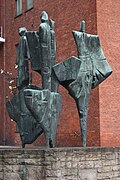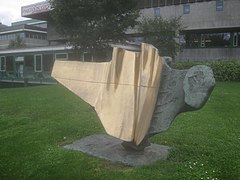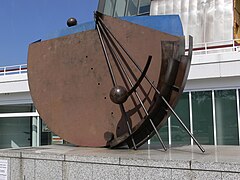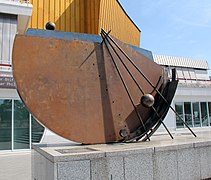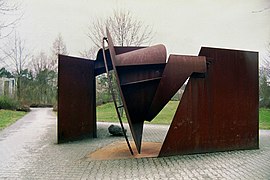Bernhard Heiliger

Bernhard Heiliger (born November 11, 1915 in Stettin , † October 25, 1995 in Berlin ) was a German sculptor .
Life
Heiliger was the fourth child of the Berlin merchant Hermann Heiliger and his wife Anna Helene Heiliger, b. Gensen. In 1911 the family moved from Berlin to Stettin, where the father settled down as a cloth and cloth dealer. The three older sisters Hildegard, Hertha and Lieselotte were born in Berlin.
Heiliger attended Barnim Middle School in Stettin from 1921, which he left after the ninth grade. From 1930 to 1933 he completed an apprenticeship as a stone sculptor and then from 1933 to 1936 received training at the Stettiner Werkschule for creative work with the Bauhaus student Kurt Schwerdtfeger . Then Heiliger studied from 1938 to 1941 at the State University of Fine Arts in Berlin, where he was in Arno Breker's class .
During his studies, Heiliger maintained contacts with Richard Scheibe and Wilhelm Gerstel . In the spring of 1939 he stayed in Paris for two weeks , where he came into contact with works of modern art that had long since disappeared from the collections in Germany. He always described his impressions there as formative; he met Aristide Maillol and Charles Despiau and studied works by Auguste Rodin , Constantin Brâncuși and Hans Arp , among others .
After his return he married the art student Ruth Maria Linde (1916–1996), who was expecting a child and shortly afterwards gave birth to a daughter, Jutta. In May 1941 her son Stefan Heiliger (furniture designer) followed and in 1942 the daughter Anita as the youngest child.
In 1941, shortly after the start of the German-Soviet War , he was drafted into the Wehrmacht and served as a radio operator on the Eastern Front. However, through the intercession of Arno Brekers, he achieved an indispensable position (so-called UK position ) in 1943 and was able to continue his work in Wriezen in the Arno Breker's workshop. Due to the decree of September 25, 1944 known as the Volkssturm , Heiliger lost his protection and was convened again. He escaped through desertion and fleeing through northern Germany, where he stayed in St. Peter-Ording , Hamburg and Bad Schwartau and saw the end of the war in May 1945, suffering from diphtheria , in a Bremen hospital.
In November 1945 he returned to Berlin, where he established himself as a freelance sculptor. From 1946 he had his first exhibitions in Karl Buchholz's private house and in the Gerd Rosen gallery . After a teaching position at the University of Applied Arts in Berlin-Weissensee 1946 to 1949 was followed by the end of 1949 the appointment as a professor at the University of the Arts by Karl Hofer , where he taught until 1986th Heiliger moved into the east wing of the studio on Käuzchensteig in Berlin-Dahlem , which had been built for Arno Breker, as his place of residence and work .
Heiliger received first international recognition for his design of the Memorial of the Unknown Political Prisoner (1953), which was awarded the Federal Government Prize and the Recognition Prize of the Institute of Contemporary Arts , London. This was followed by prominent participation in exhibitions, for example at documenta I and documenta II in Kassel (1955 and 1959) and the Venice Biennale (1956). One of the commissioned works was the figure tree created in 1957/58 for the German Pavilion at Expo 58 .
Bernhard Heiliger was a board member of the German Association of Artists from 1951 to 1960.
The honorary grave of Bernhard Heiliger is located at the Berlin Cemetery Dahlem in Section 5.
Honors
- Member of the Academy of Arts (Berlin) (1956)
- Great Art Prize of the State of North Rhine-Westphalia (1956)
- Federal Cross of Merit (1974)
- Lovis Corinth Prize (1975)
- Honorary member of the German Association of Artists (1984)
Bernhard Heiliger Foundation
The Bernhard Heiliger Foundation, founded in 1996 by Sabine Wellmann-Heiliger, with whom he was married for the fourth time since 1975, from his artistic estate is based in the historic studio building in Berlin-Dahlem, which today houses the Kunsthaus Dahlem museum Post-war modernity is located. This also shows the work of Bernhard Heiliger. Together with the community of heirs, the foundation manages the rights to Bernhard Heiliger's work. The foundation's curator is Heiliger's stepson Marc Wellmann. The foundation also receives funds from the German Class Lottery.
plant
Heiliger's diverse oeuvre ranges from an organic, smooth figuration at the beginning of his career, which in its aesthetics is reminiscent of the works of Henry Moore , to free abstraction. From the 1960s onwards, Heiliger broke away from the human figure in the form of vegetal, broken-up structures that linked to the non-representational art of European Art Informel . From the 1970s on, Heiliger came up with technoid-like spatial compositions, which then led to the musically tuned geometry of the later years. The suspension of mass and volume as well as the retention of movement in a static moment are central aspects.
The different stylistic phases in Heiliger's work go hand in hand with a change in the materials and techniques used. While the works of the 1950s and 1960s were characterized by the various casting and molding processes - stone casting, Eternit, aluminum and above all bronze - from the 1970s onwards, unique items were made from light metals, stainless steel and later almost exclusively from Corten steel . In this sense, Heiliger's work can be differentiated into an early “Bronze Age” and a late “Iron Age”.
Particularly noteworthy is a series of portrait heads of important people from the 1950s and early 1960s. Heiliger also created many large sculptures in public spaces, such as the seven-meter-high bronze sculpture “The Flame” (1962/63) on Ernst-Reuter-Platz in Berlin .
Particularly well-known works are
- Max Planck Monument, 1948–49, Berlin, Humboldt University , Ehrenhof
- Portrait head Karl Hofer , 1951
- Portrait head Alexander Camaro , 1953
- Portrait head Boris Blacher , 1954
- Portrait head Ernst Reuter , installed in 1955 in the BVG headquarters in Berlin
- Two women in relationship, inner courtyard of the Ludwig-Georgs-Gymnasium in Darmstadt
- Figurbaum, 1957–58, Bonn, Park at the Chancellor's Bungalow
- Siemens memorial wall in Berlin-Siemensstadt , 1958
- Portrait head Walter Gropius , 1959
- Dream II, 1959, Münster, West Lotto
- Portrait head Ernst May (missing)
- Portrait head Theodor Heuss , 1960
- The five continents, 1960, Kiel, Oberpostdirektion
- Portrait head Ludwig Erhard , 1962
- The Flame, 1962–63, Ernst-Reuter-Platz, Berlin
- Prelude, 1963, Berlin, Philharmonic foyer
- Portrait head Martin Heidegger , 1964
- Großer Phönix I, 1964–66, Nuremberg, in front of the Germanisches Nationalmuseum
- Relieffries, 1964–65, Bremen, House of the Bremen Citizenship
- Large Phoenix III, 1966/92, Unter den Linden, Zollernhof , Berlin
- Three vertical motifs, 1966–67, Berlin, sculpture courtyard of the Neue Nationalgalerie
- Montana I, 1968, Stuttgart, in front of the Württemberg State Library
- Sign 74 , Tucherpark, Munich
- Orbit I (1978/1983) in the possession of the Berlinische Galerie , on loan to the Klinikum im Friedrichshain in 2008
- Eye of the Nemesis, 1979–80, Berlin, Lehniner Platz in front of the Neue Schaubühne
- Day and Night, 1981–82, Stuttgart-Untertürkheim, Daimler AG
- Deus ex Machina, 1985, Sculpture Mile Hanover
gallery
- Selection of works of art
Nike (1956)
Marl
Solo exhibitions
- 1950 Bernhard Heiliger , Haus am Waldsee , Berlin
- 1951 Bernhard Heiliger , Kunstverein Hamburg, Kunstverein Oldenburg, Kaiser Wilhelm Museum Krefeld, Museum Folkwang Essen, Museum am Ostwall Dortmund, Märkisches Museum of the city of Witten, Von-der-Heydt-Museum Wuppertal
- 1956 Bernhard Heiliger: Heads from the years 1948–55 , Haus am Waldsee Berlin, Cologne Art Association, Municipal Museum Mülheim an der Ruhr, Kassel Art Association, Museum Folkwang Essen, Art Association Braunschweig
- 1957 Bernhard Heiliger: Sculpture, drawings , Haus am Waldsee, Berlin
- 1959–1960 Bernhard Heiliger: Sculptures, drawings since 1945 , Wolfsburg City Hall, Berlin Congress Hall, Mannheim City Art Hall, Lucerne Art Museum
- 1961 Bernhard Heiliger , Staempfli Gallery, New York
- 1964 Bernhard Heiliger , Galerie im Erker, St. Gallen
- 1975 Bernhard Heiliger: Sculptures and Drawings 1960–1975 , Neuer Berliner Kunstverein and Academy of the Arts, Berlin
- 1981 Bernhard Heiliger: 10 large sculptures on the moor pasture , Galerie Levy, Hamburg
- 1984 Bernhard Heiliger, sculptures , Roswitha Haftmann Modern Art Gallery , Zurich
- 1985 Bernhard Heiliger: retrospective , Wilhelm-Lehmbruck-Museum , Duisburg
- 1988 Bernhard Heiliger, sculptures, collages, drawings , Roswitha Haftmann Modern Art Gallery, Zurich
- 1991 Bernhard Heiliger: Sculptures in the pleasure garden. Relief objects and collaged drawings in the Altes Museum , Staatliche Museen zu Berlin, Nationalgalerie, Berlin
- 1995 Bernhard Heiliger retrospective , Art and Exhibition Hall of the Federal Republic of Germany , Bonn
- 1998 retrospective , National Museum, Szczecin (Poland)
- 2000–2002 Bernhard Heiliger - The Heads , Georg-Kolbe-Museum Berlin, Von-der-Heydt-Museum Wuppertal, Kloster Unser Lieben Frauen, Kunstmuseum Magdeburg a. a.
- 2005–2006 Bernhard Heiliger 1915–1995: Cosmos of a Sculptor , Martin-Gropius-Bau , Berlin
Books and catalogs
- Marc Wellmann (Ed.): Bernhard Heiliger 1915–1995: Monograph and catalog raisonné. Commissioned by the Bernhard Heiliger Foundation, Wienand Verlag, Cologne 2005, ISBN 3-87909-869-7 .
- Bernhard Heiliger - The heads. Wienand Verlag, Cologne 2000, ISBN 3-87909-737-2 .
- Lothar Romain , Siegfried Salzmann (Ed.): Bernhard Heiliger. Propylaea, Frankfurt am Main, Berlin 1989, ISBN 3-549-05308-8 .
- Bernhard Heiliger: Retrospective, 1945 to 1995. Cantz Verlag, [Ostfildern] 1995, ISBN 3-89322-754-7 .
- Saint, Bernhard . In: Hans Vollmer (Hrsg.): General Lexicon of Fine Artists of the XX. Century. tape 2 : E-J . EA Seemann, Leipzig 1955, p. 406 .
Web links
- Literature by and about Bernhard Heiliger in the catalog of the German National Library
- Website of the Bernhard Heiliger Foundation
- Materials by and about Bernhard Heiliger in the documenta archive
Individual evidence
- ↑ kuenstlerbund.de: Board members of the German Association of Artists since 1951 ( memento from September 25, 2015 in the Internet Archive ) (accessed on August 19, 2015).
- ↑ The money is there - controversial exhibition project can begin. stadtrand-nachrichten.de from January 28, 2013, accessed on November 28, 2015.
- ↑ Ludmila Vachtova. Roswitha Haftmann . P. 103
- ↑ Ludmila Vachtova. Roswitha Haftmann . P. 104
| personal data | |
|---|---|
| SURNAME | Saint, Bernhard |
| BRIEF DESCRIPTION | German sculptor |
| DATE OF BIRTH | November 11, 1915 |
| PLACE OF BIRTH | Szczecin |
| DATE OF DEATH | October 25, 1995 |
| Place of death | Berlin |



